Solar eclipse of April 30, 1957
An annular solar eclipse occurred on April 30, 1957. A solar eclipse occurs when the Moon passes between Earth and the Sun, thereby totally or partly obscuring the image of the Sun for a viewer on Earth. An annular solar eclipse occurs when the Moon's apparent diameter is smaller than the Sun's, blocking most of the Sun's light and causing the Sun to look like an annulus (ring). An annular eclipse appears as a partial eclipse over a region of the Earth thousands of kilometres wide. This annular solar eclipse was non-central. Instead, over half of the antumbral shadow fell off into space throughout the eclipse. Gamma had a value of 0.9992. Annularity was visible from northern Soviet Union (today's Russia) and Bear Island, the southernmost island of Svalbard, Norway.
| Solar eclipse of April 30, 1957 | |
|---|---|
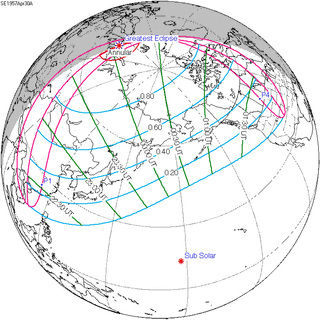 Map | |
| Type of eclipse | |
| Nature | Annular |
| Gamma | 0.9992 |
| Magnitude | 0.9799 |
| Maximum eclipse | |
| Duration | - |
| Coordinates | 70.6°N 40.3°E |
| Max. width of band | - km |
| Times (UTC) | |
| Greatest eclipse | 0:05:28 |
| References | |
| Saros | 118 (65 of 72) |
| Catalog # (SE5000) | 9414 |
This was the last of 57 umbral eclipses of Solar Saros 118. The 1st was in 947 AD and the 57th was in 1957. The total duration is 1010 years.
While it was an annular solar eclipse, it was a non-central solar eclipse.
Related eclipses
Solar eclipses of 1957–1960
This eclipse is a member of a semester series. An eclipse in a semester series of solar eclipses repeats approximately every 177 days and 4 hours (a semester) at alternating nodes of the Moon's orbit.[1]
| Solar eclipse series sets from 1957–1960 | ||||
|---|---|---|---|---|
| Descending node | Ascending node | |||
| Saros | Map | Saros | Map | |
| 118 |  1957 April 30 Annular (non-central) |
123 | 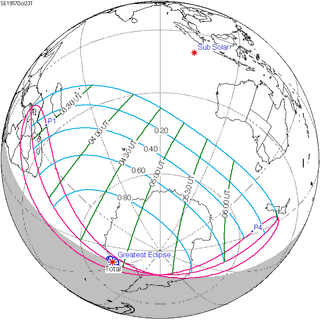 1957 October 23 Total (non-central) | |
| 128 |  1958 April 19 Annular |
133 |  1958 October 12 Total | |
| 138 | 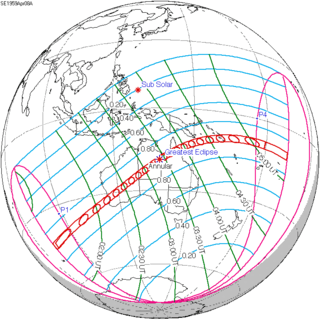 1959 April 8 Annular |
143 | 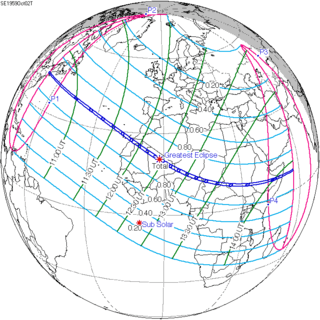 1959 October 2 Total | |
| 148 | 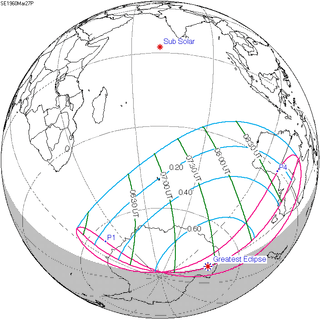 1960 March 27 Partial |
153 | 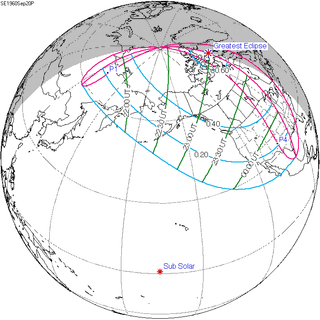 1960 September 20 Partial | |
Saros 118
It is a part of Saros cycle 118, repeating every 18 years, 11 days, containing 72 events. The series started with partial solar eclipse on May 24, 803 AD. It contains total eclipses from August 19, 947 AD through October 25, 1650, hybrid eclipses on November 4, 1668 and November 15, 1686, and annular eclipses from November 27, 1704 through April 30, 1957. The series ends at member 72 as a partial eclipse on July 15, 2083. The longest duration of total was 6 minutes, 59 seconds on May 16, 1398.
| Series members 62–72 occur between 1901 and 2083: | ||
|---|---|---|
| 62 | 63 | 64 |
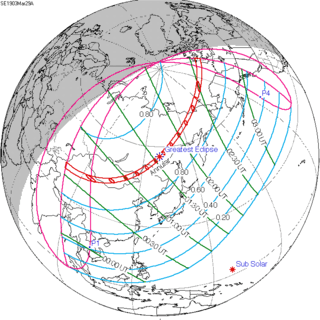 Mar 29, 1903 |
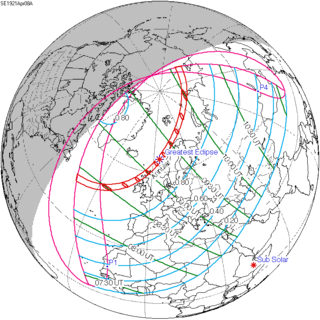 Apr 8, 1921 |
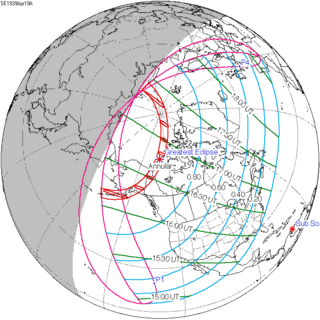 Apr 19, 1939 |
| 65 | 66 | 67 |
 Apr 30, 1957 |
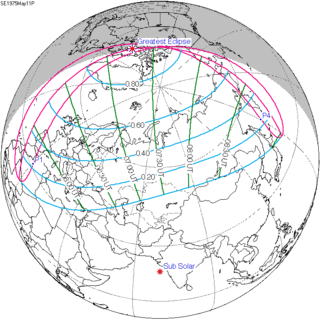 May 11, 1975 |
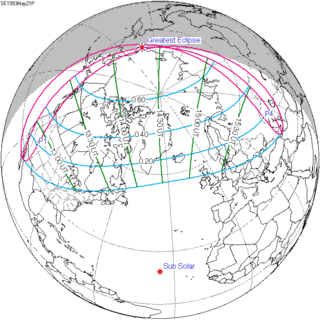 May 21, 1993 |
| 68 | 69 | 70 |
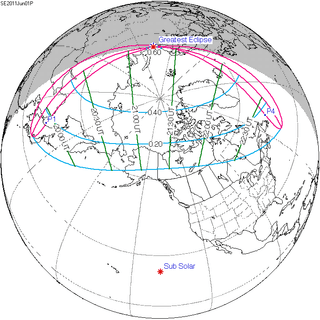 Jun 1, 2011 |
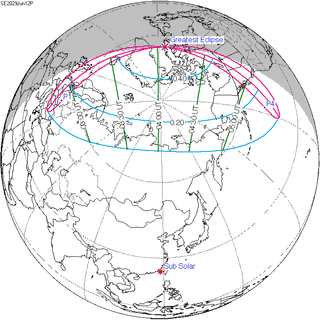 Jun 12, 2029 |
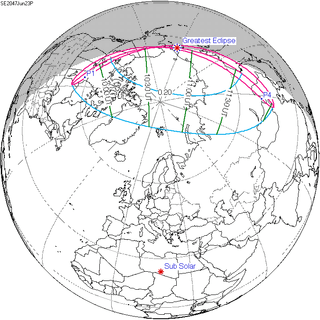 Jun 23, 2047 |
| 71 | 72 | |
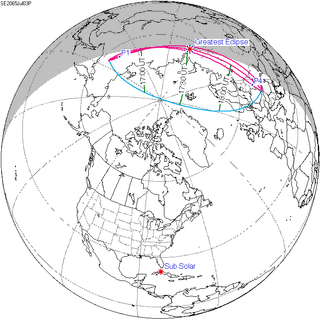 Jul 3, 2065 |
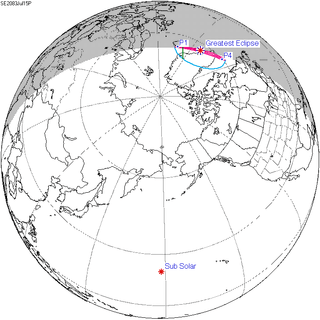 Jul 15, 2083 | |
Metonic series
The metonic series repeats eclipses every 19 years (6939.69 days), lasting about 5 cycles. Eclipses occur in nearly the same calendar date. In addition, the octon subseries repeats 1/5 of that or every 3.8 years (1387.94 days). All eclipses in this table occur at the Moon's descending node.
| 21 eclipse events, progressing from north to south between July 11, 1953 and July 11, 2029 | ||||
|---|---|---|---|---|
| July 10–12 | April 29–30 | February 15–16 | December 4–5 | September 21–23 |
| 96 | 98 | 100 | 102 | 104 |
| July 12, 1915 | April 30, 1919 | February 15, 1923 | December 5, 1926 | September 22, 1930 |
| 106 | 108 | 110 | 112 | 114 |
| July 11, 1934 | April 30, 1938 | February 15, 1942 | December 4, 1945 | September 22, 1949 |
| 116 | 118 | 120 | 122 | 124 |
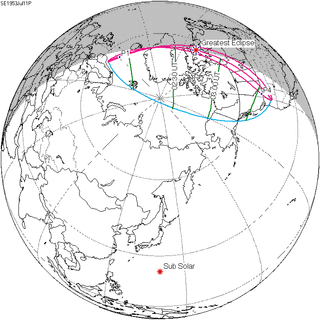 July 11, 1953 |
 April 30, 1957 |
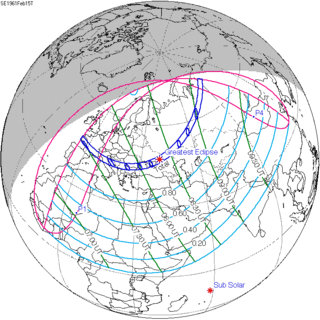 February 15, 1961 |
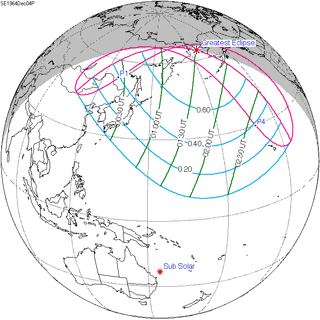 December 4, 1964 |
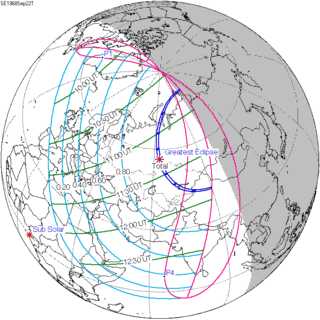 September 22, 1968 |
| 126 | 128 | 130 | 132 | 134 |
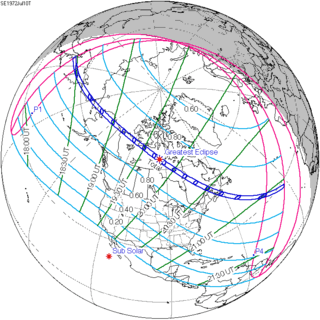 July 10, 1972 |
 April 29, 1976 |
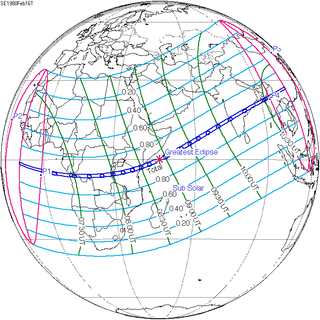 February 16, 1980 |
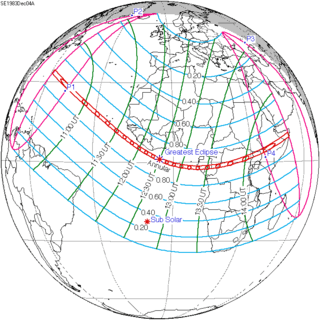 December 4, 1983 |
 September 23, 1987 |
| 136 | 138 | 140 | 142 | 144 |
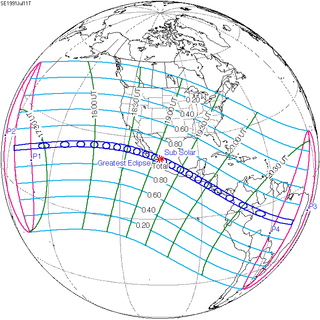 July 11, 1991 |
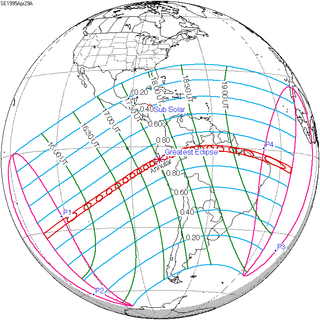 April 29, 1995 |
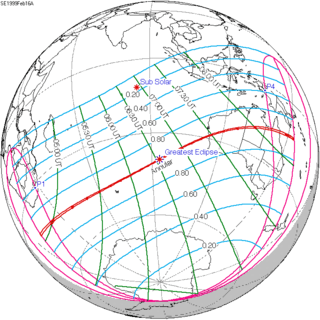 February 16, 1999 |
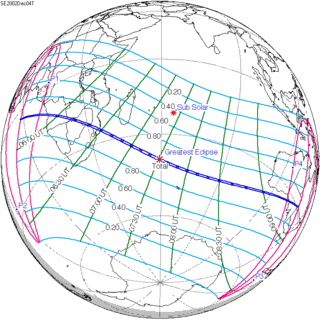 December 4, 2002 |
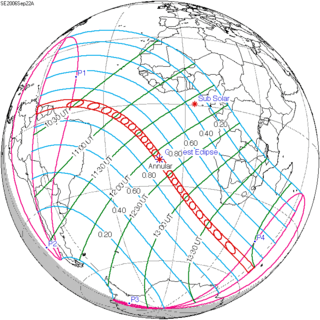 September 22, 2006 |
| 146 | 148 | 150 | 152 | 154 |
 July 11, 2010 |
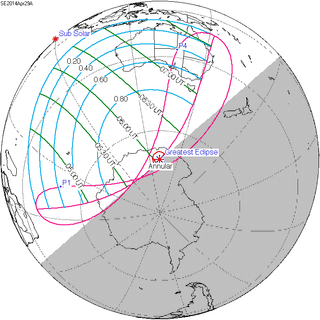 April 29, 2014 |
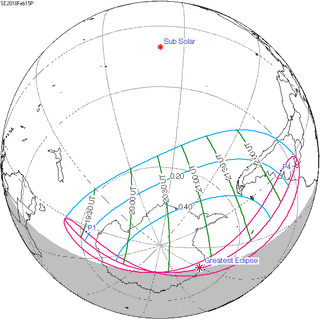 February 15, 2018 |
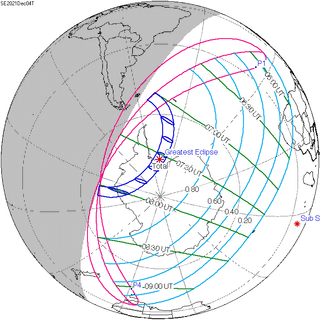 December 4, 2021 |
 September 21, 2025 |
| 156 | 158 | 160 | 162 | 164 |
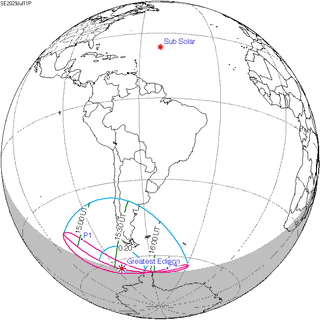 July 11, 2029 |
April 29, 2033 | February 15, 2037 | December 4, 2040 | September 21, 2044 |
Notes
- van Gent, R.H. "Solar- and Lunar-Eclipse Predictions from Antiquity to the Present". A Catalogue of Eclipse Cycles. Utrecht University. Retrieved 6 October 2018.
References
- Earth visibility chart and eclipse statistics Eclipse Predictions by Fred Espenak, NASA/GSFC
.jpg)
